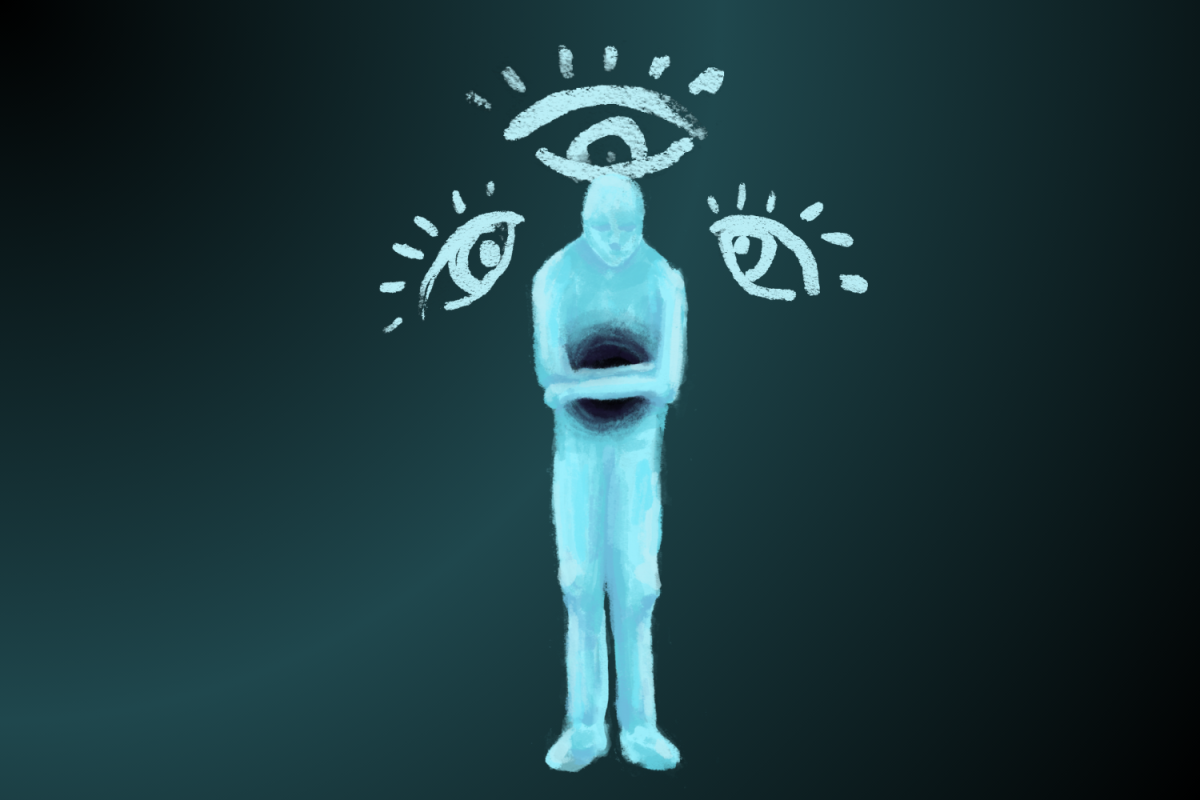A distressed teenager panics as they take a quick scan around their bathroom. To their disappointment, they find countless strands of hair scattered across the sink, countertops and bathroom floor. Hair loss is one of the many physical symptoms experienced by people battling eating disorders. Eating disorders are behavioral conditions that cause persistent disturbances in eating behaviors and can negatively affect a person’s mental and physical health. Eating disorders come in different forms and can have many causes, all of which greatly impact teenagers and adolescents.
According to the National Comorbidity Survey Adolescent Supplement, about 3% of people will develop an eating disorder sometime in their life. Some of the most common forms of eating disorders include anorexia nervosa, bulimia and binge eating. Anorexia is characterized by reduced food intake due to a fear of being overweight and is often associated with a distorted body image. Those suffering from bulimia tend to purge after eating to avoid weight gain through self-induced vomiting, laxatives or over-exercising. Binge Eating Disorder is characterized by the intake of a large amount of food over a short period of time. Binge eating is often associated with bulimia as well, and anorexia, a subtype of binge-eating and purging.
These behaviors can manifest in many different ways, each affecting a person differently. For example, orthorexia is defined as a person demonstrating a fixation on eating only “pure” food such as dairy and grains while avoiding artificial or processed foods. People with Avoidant/Restrictive Food Intake Disorder demonstrate extreme selectivity with food intake and limit food based on factors such as smells, colors, textures and tastes. Pica is a disorder that describes people with the compulsion to eat inedible objects, including rocks, paper and crayons. These eating disorders drastically affect the mental and physical health of affected individuals.
“There are different categories for eating disorders such as anorexia and bulimia, but there are also others that a lot of people don’t know about,” school-based therapist Jenna Starnes said. “The Avoid/Restrictive eating disorder is less about body image and more about being a picky eater and having an aversion to particular textures or tastes. With this eating disorder, it really starts becoming a problem when you see nutritional deficits.”
A key aspect of eating disorders is the relationship the individual has with food. People suffering from binge eating disorder often turn to food as a method of feeling comfort. However, food is meant to be fuel for one’s body, not a coping mechanism to deal with stress.
“A healthy relationship with food is one where you care about your nutrition and what you eat, but you don’t spend every second of your life thinking about it,” Culinary Arts Club public relations officer Becca Han said.
All irregular eating behaviors can bring about negative effects on the body, both mentally and physically. Some of the common effects include hormonal imbalances, weakened immune systems and obsessive behaviors. Anorexia in particular often leads to thinning of the bones, low blood pressure or brittle hair and nails. The disorder can also lead to loss of muscle mass, in which the heart, a muscle, shrinks in order to conserve energy. Frequent self-induced vomiting, a symptom of bulimia, can lead to tooth decay, swollen salivary glands or organ failure. In the long run, bulimia could also result in hormonal imbalance, acid reflux and troubles with regulating body temperature.
The NCSAS also states that the prevalence of binge eating disorder was twice as high among females than among males, with the rates being 1.6% and 0.8%, respectively. However, challenges faced by men who suffer from eating disorders manifest in severe forms as well. According to Eating Disorder Hope, 33% of men have used unhealthy behaviors at one point as a method of altering their weight or body.
“I think the media doesn’t cover both men and women equally when it comes to eating disorders,” sophomore Gauresh Srivastava said. “We tend to see more women than men, but just because men aren’t really shown doesn’t mean we don’t go through these problems too.”
Eating disorders can develop from numerous external factors, including but not limited to genetic, biological, behavioral, psychological and social influences. EDH states that traumatic experiences with abuse, whether sexual, physical, verbal or emotional, are all tied to a higher risk of developing eating disorders.
“There’s no one specific thing that causes eating disorders because there are a number of layers,” Starnes said. “There’s also a correlation to things such as perfectionistic thinking, rigidity and high parental criticism. Still, every individual is different, and it depends on what type of eating disorder they are dealing with.”
Among high school students, body image has become a prevalent issue, as many focus on the way their body looks or the exact scale reading of their weight. Many turn to social media, which can emphasize insecurities. With phones and electronic devices so close within reach, it is easy to make comparisons with celebrities and online influencers. Often, individuals with thin, fit or conventionally attractive bodies are used as inspiration for the “perfect” body, which can incite unrealistic expectations.
“We are all a little bit addicted to our phones these days, and the more time we spend using social media the worse it gets,” Han said. “We see these pictures of models and influencers, and even though sometimes they’re editing their photos, it still results in negative body image.”
The expectations of some sports are major reasons behind these actions, as Eating Disorder Hope also states that up to 45% of female athletes and 19% of male athletes struggle with eating disorders. These disorders among athletes often stem from their unique relationships with nutrition and exercise, and the results of these conditions could eventually negatively impact the performance of an athlete. Female athletes in gymnastics, dance and figure skating as well as men in wrestling, equestrianism and body-building are more likely to have a large focus on controlling their food intake.
“During wrestling season I need to cut down on the food I eat to maintain my weight to fit in weight classes,” Srivastava said. “While I was cutting, I was exhausted during the entire school day and couldn’t pay attention to my homework.”
People suffering from eating disorders often seek out resources such as therapists and counselors. Eating disorder helplines are also very useful in providing someone for people to speak to about their problems. Regular medical checkups for monitoring one’s physical health are essential to recovery, as well as developing healthy coping mechanisms to deal with stress. Having a strong support group consisting of friends and family members will help with providing a sense of comfort and belonging. In 1986, a group of people from different countries gathered to discuss organizing an international Eating Disorders Awareness Week. Generally held in late February or early March, the annual campaign aims to educate people about eating disorders and provide support for the affected individuals.
“What helped me the most was learning from people who had similar experiences but have recovered rather than looking at textbook solutions,” junior Kelly Chu said. “Hearing from real experiences of people who went through the same struggles helped me understand that my eating disorder wasn’t necessarily related to body image, but it more so stemmed from underlying issues.”
To support loved ones who may be struggling with eating disorders, people can create healthier environments by refraining from talking about bodies and food in general.
“We should stop making so many of our comments and compliments based on appearances,” Starnes said. “It’s best to just not talk about people’s bodies and how much or how little you ate.”
Due to the prevalence of teenagers developing eating disorders, it is important to be aware of their negative effects. To combat these issues, there are many resources that one can turn to for help.
“I want people going through these problems to realize that they are not alone,” Han said. “At the end of the day, you are going to get out of it and there is a solution.”










































































